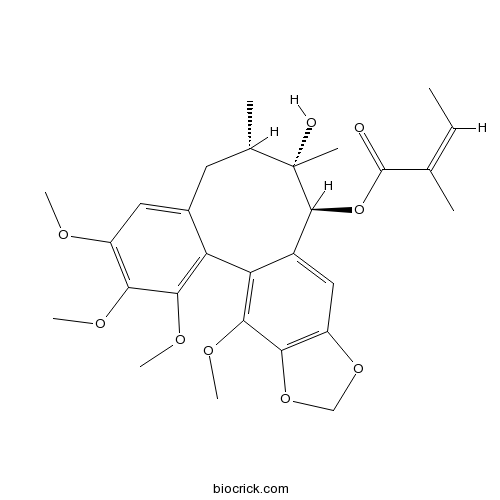Gomisin FCAS# 62956-47-2 |

Quality Control & MSDS
3D structure
Package In Stock
Number of papers citing our products

| Cas No. | 62956-47-2 | SDF | Download SDF |
| PubChem ID | 51003489 | Appearance | Powder |
| Formula | C28H34O9 | M.Wt | 514.6 |
| Type of Compound | Lignans | Storage | Desiccate at -20°C |
| Solubility | Soluble in Chloroform,Dichloromethane,Ethyl Acetate,DMSO,Acetone,etc. | ||
| SMILES | CC=C(C)C(=O)OC1C2=CC3=C(C(=C2C4=C(C(=C(C=C4CC(C1(C)O)C)OC)OC)OC)OC)OCO3 | ||
| Standard InChIKey | ZIBVHHLTJKYXEB-RZGKOBFOSA-N | ||
| Standard InChI | InChI=1S/C28H34O9/c1-9-14(2)27(29)37-26-17-12-19-23(36-13-35-19)25(34-8)21(17)20-16(10-15(3)28(26,4)30)11-18(31-5)22(32-6)24(20)33-7/h9,11-12,15,26,30H,10,13H2,1-8H3/b14-9-/t15-,26-,28-/m0/s1 | ||
| General tips | For obtaining a higher solubility , please warm the tube at 37 ℃ and shake it in the ultrasonic bath for a while.Stock solution can be stored below -20℃ for several months. We recommend that you prepare and use the solution on the same day. However, if the test schedule requires, the stock solutions can be prepared in advance, and the stock solution must be sealed and stored below -20℃. In general, the stock solution can be kept for several months. Before use, we recommend that you leave the vial at room temperature for at least an hour before opening it. |
||
| About Packaging | 1. The packaging of the product may be reversed during transportation, cause the high purity compounds to adhere to the neck or cap of the vial.Take the vail out of its packaging and shake gently until the compounds fall to the bottom of the vial. 2. For liquid products, please centrifuge at 500xg to gather the liquid to the bottom of the vial. 3. Try to avoid loss or contamination during the experiment. |
||
| Shipping Condition | Packaging according to customer requirements(5mg, 10mg, 20mg and more). Ship via FedEx, DHL, UPS, EMS or other couriers with RT, or blue ice upon request. | ||
| Description | Standard reference |
| In vitro | Production of lignans in calluses of Schisandra chinensis.[Pubmed: 21927855]J Nat Med. 2012 Apr;66(2):373-6.
|

Gomisin F Dilution Calculator

Gomisin F Molarity Calculator
| 1 mg | 5 mg | 10 mg | 20 mg | 25 mg | |
| 1 mM | 1.9433 mL | 9.7163 mL | 19.4326 mL | 38.8651 mL | 48.5814 mL |
| 5 mM | 0.3887 mL | 1.9433 mL | 3.8865 mL | 7.773 mL | 9.7163 mL |
| 10 mM | 0.1943 mL | 0.9716 mL | 1.9433 mL | 3.8865 mL | 4.8581 mL |
| 50 mM | 0.0389 mL | 0.1943 mL | 0.3887 mL | 0.7773 mL | 0.9716 mL |
| 100 mM | 0.0194 mL | 0.0972 mL | 0.1943 mL | 0.3887 mL | 0.4858 mL |
| * Note: If you are in the process of experiment, it's necessary to make the dilution ratios of the samples. The dilution data above is only for reference. Normally, it's can get a better solubility within lower of Concentrations. | |||||

Calcutta University

University of Minnesota

University of Maryland School of Medicine

University of Illinois at Chicago

The Ohio State University

University of Zurich

Harvard University

Colorado State University

Auburn University

Yale University

Worcester Polytechnic Institute

Washington State University

Stanford University

University of Leipzig

Universidade da Beira Interior

The Institute of Cancer Research

Heidelberg University

University of Amsterdam

University of Auckland

TsingHua University

The University of Michigan

Miami University

DRURY University

Jilin University

Fudan University

Wuhan University

Sun Yat-sen University

Universite de Paris

Deemed University

Auckland University

The University of Tokyo

Korea University
- (2-Benzothiazolylthio)acetic acid
Catalog No.:BCC8387
CAS No.:6295-57-4
- 6-Methoxy-4-methylcoumarin
Catalog No.:BCN6537
CAS No.:6295-35-8
- Morusinol
Catalog No.:BCN4168
CAS No.:62949-93-3
- Mulberrin
Catalog No.:BCN4167
CAS No.:62949-79-5
- Kuwanon A
Catalog No.:BCN2944
CAS No.:62949-77-3
- H-D-Pro-NH2
Catalog No.:BCC3024
CAS No.:62937-45-5
- Procaterol hydrochloride
Catalog No.:BCC6937
CAS No.:62929-91-3
- Heptanal oxime
Catalog No.:BCN2267
CAS No.:629-31-2
- Cefoperazone
Catalog No.:BCC3748
CAS No.:62893-19-0
- Hecubine
Catalog No.:BCN7467
CAS No.:62874-52-6
- TP 003
Catalog No.:BCC6169
CAS No.:628690-75-5
- Senampeline B
Catalog No.:BCN2031
CAS No.:62860-52-0
- Gomisin G
Catalog No.:BCN2269
CAS No.:62956-48-3
- Gnetucleistol D
Catalog No.:BCN3400
CAS No.:629643-26-1
- Boc-Tle-OH
Catalog No.:BCC3343
CAS No.:62965-35-9
- XL335
Catalog No.:BCC4501
CAS No.:629664-81-9
- 6-Aminoquinoxaline
Catalog No.:BCC8767
CAS No.:6298-37-9
- Staurosporine
Catalog No.:BCC3612
CAS No.:62996-74-1
- Androstenedione
Catalog No.:BCC8296
CAS No.:63-05-8
- Primaquine Diphosphate
Catalog No.:BCC4706
CAS No.:63-45-6
- H-Met-OH
Catalog No.:BCC2993
CAS No.:63-68-3
- Sulfanilamide
Catalog No.:BCC4858
CAS No.:63-74-1
- L-Phenylalanine
Catalog No.:BCN3818
CAS No.:63-91-2
- Phenoxybenzamine HCl
Catalog No.:BCC4334
CAS No.:63-92-3
Production of lignans in calluses of Schisandra chinensis.[Pubmed:21927855]
J Nat Med. 2012 Apr;66(2):373-6.
Calluses were induced from leaves of Schisandra chinensis Baillon (Schisandraceae). Murashige-Skoog (MS) and Woody Plant (WP) media were used for the induction, in full and half strength (1/2 MS or 1/2 WP) salt formulations. Test media were solidified with 0.25% gelrite and supplemented with 2% sucrose and various concentrations and combinations of 2,4-dichlorophenoxyacetic acid (2,4-D), kinetin (Kin), 3-indolebutyric acid (IBA), and 6-benzylaminopurine (BAP). Optimal conditions for callus induction and growth were found to be 1/2 MS medium containing 0.02 mg/l Kin and 0.2 mg/l 2,4-D. Chloroform extracts of all induced calluses contained gomisin A and F as major components. Gomisin A and F contents of calluses that were cultured under the optimal conditions mentioned above were highest compared to the calluses incubated with other combinations of plant hormones and media. Subculture, by repeated transfer of cultured calluses to fresh medium, caused no decrease in the production of gomisin A and F. Optimal conditions for lignan production were found to be 1/2 MS medium supplemented with 0.05 mg/1 Kin and 0.2 mg/l 2,4-D. Under these conditions, gomisin A and Gomisin F contents were 0.05 and 0.04% of callus dry weight, respectively.


